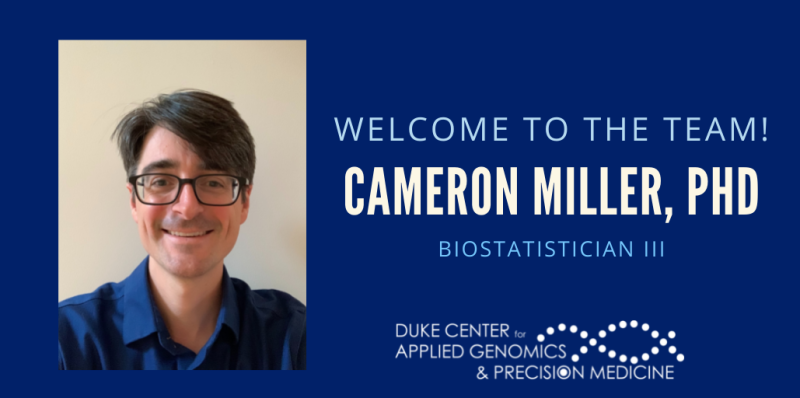
Cameron Miller, PhD, recently joined CAGPM as a Biostatistician III. He is originally from Charlotte, North Carolina, received his BS in Biology from Duke University in 2008, and his PhD in Biostatistics from Medical University of South Carolina (MUSC) in 2019. To get to know Dr. Miller a little more, we asked him the following questions:
How did you become interested in biostatistics and bioscience?
I was in the Biochemistry Department at MUSC working on identifying novel antimicrobials targeted against Pseudomonas aeruginosa, and I took a required Intro to Biostatistics course. I was the only basic science student excited to take the class. I wanted to know how to analyze my laboratory-derived data with confidence. After that intro course I kept taking biostatistics courses, and I got hooked, so I restarted my graduate program to pursue a PhD in biostatistics.
What excites you the most about data science?
In short, I love the ability of data science to make sense of data. It was what drew me to biostatistics in the first place. I get excited about being able to identify the signal underlying complex and multidimensional data and then derive meaningful interpretations.
What should people know about the VA Cooperative Studies Program (CSP) you’re involved with?
CSP #380 is a research group within the VA that is dedicated to understanding the development and progression of colorectal cancer. As part of CSP #380 I was developing methods to predict the development of advanced lesions in the colorectum using entire patient colonoscopic records. Colonoscopic findings are typically unstructured data found in provider notes. Collaborating with a data science group within the VA, we recently applied for and received a VA Merit Award to generate structured data from clinical notes in the electronic health record using natural language processing and then incorporate those structured data into the model I developed in my time at CSP #380. If successful, that model will identify features in the colonoscopic record associated with the future development of advanced lesions and will also provide information about when patients are at highest risk of developing advanced lesions. The ultimate goal of this work is to understand when patients should be screened for colorectal cancer because the current guidelines are overly broad and lead to many unnecessary procedures. Learn more.
Other studies/projects you want to elaborate on?
My dissertation focused on modeling imaging mass spectrometry (IMS) data. In IMS, the relative abundances of hundreds to many thousands of molecular fragments are measured over a two-dimensional space. The data are characterized by high dimensionality, excess zeros, and inherent spatial autocorrelation. Despite being a couple of years removed from my dissertation work, I am still passionate about IMS and spatial statistics.
How has mentorship positioned you to where you are today?
I would not be here without the mentorship and guidance of many people, but I do want to single out my dissertation mentor, Elizabeth Hill, or Betsy as I came to call her once I successfully defended. I was a naïve bench scientist trying to transition to biostatistics when I met Betsy as a student in her Theory II class. She saw potential in me and took me on as her mentee. I have not met a more dedicated or focused investigator in my short career. While dedication can’t be taught, Betsy did instill in me an understanding that all the details matter. As a brief example, the data we worked with in my dissertation were lognormally distributed, and the first thing Betsy had me do was derive important properties of the lognormal distribution. Other students thought it was silly to do that kind of work, but I could see the value in building a strong foundation, and I try to continue that behavior as much as possible today. From the start of our work together Betsy set a high standard and never wavered in that standard, and I think that is a large part of why I’m here at the CAGPM today.
What would you tell someone interested in pursuing a career as a biostatistician?
I would say two things. First, being a biostatistician is a broad and flexible career. There are many options for one’s research focus and role in that research. Second, now is the right time to become a biostatistician. There is such an appreciation for data science now, and with the constant development of new technologies, like sequencing and molecular imaging platforms, there is an overwhelming need to develop new analytical approaches.
What do you like to do outside of your work?
I have two small boys at home, so my life outside of work is family. While most weekends my wife and I juggle kids and housework, when we get the chance we love to go to Bond Park or pick whatever fruit is in season. My older son loves strawberries, so that’s a frequent choice when they’re in season. In the little time I do have to relax, I love to watch football and play fantasy football. My wife is from Pittsburgh, so we have a friendly rivalry when the Steelers and Panthers play.
What do you like best about Durham/Duke?
Duke is special to me because I went here for my undergraduate degree. I have a lot of fond memories tied to Duke, from my first Duke basketball game to spending summers in the lab and working at The Lobby Shop in the Bryan Center. I’m happy to have found my way back to what I think is an outstanding institution.
Anything else?
If anybody knows of some fun family activities in the area, I am all ears!